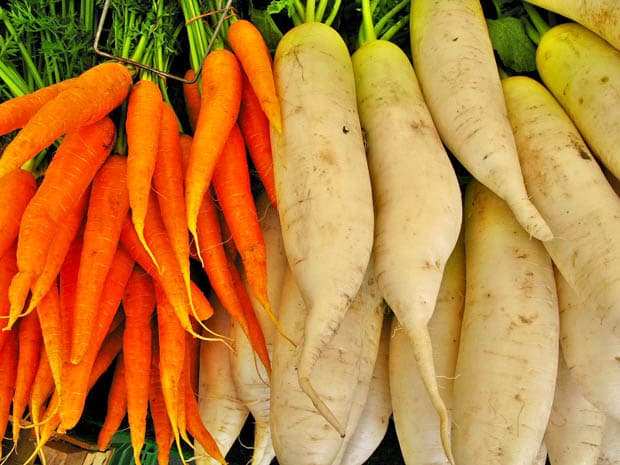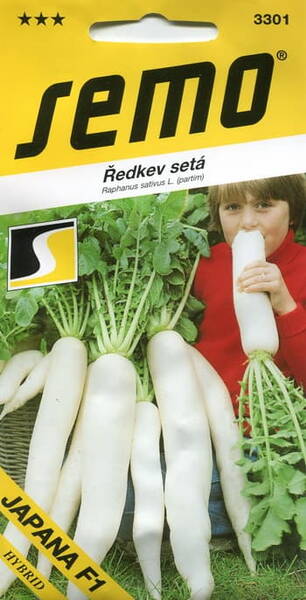Daikon is an unpretentious plant and can grow on different types of soil, but it gives the highest yield on light, fertile soils. Preparation of the soil for cultivation should begin in early spring, applying humus and mineral fertilizers. The best sowing time is early July.
Seeds are sown on ridges in small holes to a depth of 2-3 cm, 2-3 pcs. in one hole with a distance between rows of 5 cm, and between plants in a row - 25 cm.
After the emergence of seedlings and the formation of 2-3 true leaves, the plants are thinned, removing weak seedlings.
Root vegetables should be harvested in dry weather and stored in sand boxes for storage.

Oriental Radish. Bot.: Raphanus sativus L. (partim)
What vegetable crops can and should be sown in August?
Vegetables begin to ripen at a fast pace in the garden, so the beds are vacated, remaining unclaimed until next spring (which is very impractical), since at the end of summer many more useful crops can be sown, which will have time to give a full harvest before the onset of the autumn cold weather.
What can be guaranteed to be sown at the end of summer:
Peas are a cold-resistant crop, which is traditionally sown in late April - early May. In June-July, they harvest, remove the tops, and that's it. Although peas can also be sown in summer: early ripening pea varieties ripen within 45-60 days. If you sow them at the beginning of August, they will give a roll-valuable crop in the middle of September. And if it gets colder by the time of ripening, this is not at all scary, because peas even tolerate small frosts - up to -6 ° C.
Peas can be sown after cucumbers or early-maturing potatoes. You can also plant it on the beds with tomatoes - in the place where the bushes for some reason died. And also a good place for him - in the planting of corn, where he can curl along its trunks.
Recommended varieties: "Meteor", "Cabree", "Avola", "Ambrosia" - asparagus-type sugar peas (fiberless pod).
Radish.
This vegetable is the same story as with peas - most gardeners traditionally grow it in the spring. But radish ripens very quickly - in early varieties, roots ripen in 18-20 days. Therefore, radishes can be sown in August as well. And given that this culture is very cold-resistant (the leaves can withstand frosts down to -8 ° C), then it can be sown until September.
Radishes can be sown after green crops (lettuce, spinach, arugula) or after early potatoes. You can also sow it on occupied beds: in the aisles of tomatoes or beans, radish roots ripen perfectly in their light shade.
Suitable varieties for summer sowing (weakly shooting): red round "Jõgeva 189", long with a white tip "18 days", purple round "Malaga", white round "Snezhka" and other interesting varieties.
Daikon (Oriental radish).
Few people grow this valuable root crop, so even now it remains in the category of rarities. However, this is understandable: there would be room for the usual root crops - radish, radish. And there is usually no place for the daikon. But you not only want to try, but also need to, because August is the time for experiments!
Early daikon varieties ripen in just 45-48 days, and if sown at the beginning of the month, you can safely harvest in mid-September. And there will be no problems with cold weather - culture
this cold-resistant (adult plants can withstand frosts down to -5 ° C).
The same vacated areas are suitable for him as for radishes.
Suitable varieties of daikon for late summer sowing: Yapana, Yarola, Minovashi.
Cucumbers.
Most likely, our proposal to sow cucumbers in August will seem strange, but ultra-early ripening varieties ripen within 35-40 days, that is, when sown at the beginning of the month, they will harvest in the first half of September. And the first month of autumn is often still warm in the current climatic situation (even if early frosts happen, the plants can simply be covered with non-woven material: spunbond, for example).
Cucumbers can be sown after radishes and green crops.
Varieties and hybrids for late summer sowing: "Adam" F1, "Dirigent" F1, "Karlos" F1, "Everest" F1 and other early ripening cucumbers from the treasury of achievements of modern breeding.
Chinese cabbage.
This type of cabbage ripens longer than radishes and peas: 60-70 days. That is, when sown in early August, it will yield a crop in early October. And if autumn comes early, then it will also have to be covered with non-woven agrotextile fabric (this is not difficult, so it makes sense to sow it too).
Peking cabbage can be sown after cucumbers, early potatoes, radishes, or peas.
Pak-choi is a stalked chinese cabbage.
This cold-resistant cabbage can be harvested after 40 days, so it can be sown throughout August.
But keep in mind - you cannot sow Chinese cabbage in large quantities, since its leaves are good while they are young. And then they get rude. Therefore, make a small bed in order to have time to harvest and eat the crop before the leaves are coarse. Moreover, the yield with summer sowing of Chinese cabbage always turns out to be higher than with spring sowing.
It can be sown in place of dug up young potatoes, after cucumbers, radishes and peas. And you can also sow it in flower beds - it has very beautiful leaves with multi-colored petioles: green, white and even purple.
Summer sowing varieties: "Cash" F1, Pac Choy.
Japanese cabbage.
It is better known as "Mizuna salad", although it is not a salad at all, but cabbage is one of its leafy varieties.
Japanese cabbage is very early ripening - the harvest ripens in 40 days, so it can be sown throughout August (besides, it is not at all afraid of accidental September cold snaps).
For Mizune, the same plots are suitable as for Chinese cabbage and Chinese cabbage.
Green crops.
Leafy vegetables that are grown for the purpose of obtaining fresh herbs: various salads, watercress, field salad (valerianella), mustard, arugula and herbs - dill, parsley, coriander (cilantro).
All of them have the ability to quickly increase the green mass - the crop can be harvested in a month, or even earlier! In addition, all these plants are cold-resistant - they are not afraid of light September frosts.
Where to sow? Absolutely any free piece of land is suitable for these crops ...
With varieties for late summer sowing, everything is simple - any are suitable.
Attention: during spring sowing, the seeds of all these crops sprout without problems - there is still a lot of moisture in the soil, it was saturated with it from melt water. In addition, there is no strong water in the spring, and the soil remains wet for a long time after watering. But when sowing in August, problems may arise: July is the hottest month of the year, the soil is very dry, so the crops will need to be watered often or covered with a film.















